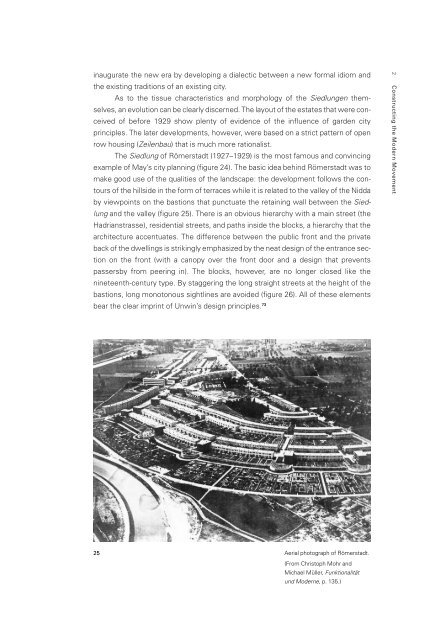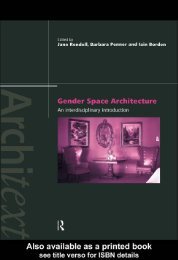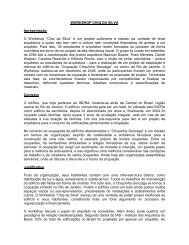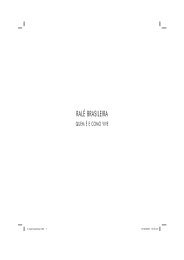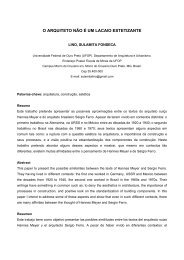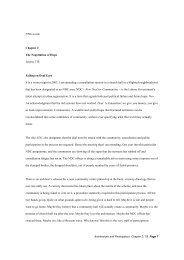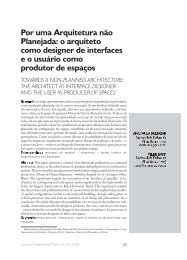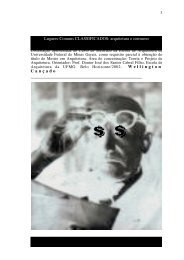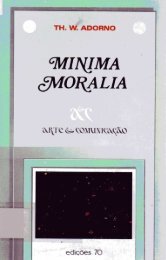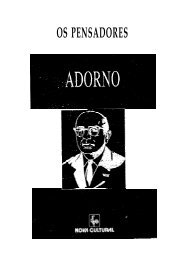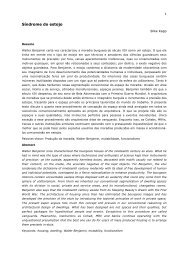- Page 2 and 3:
This Page Intentionally Left Blank
- Page 4 and 5:
MIT Press | Cambridge, Massachusett
- Page 6 and 7:
© 1999 Massachusetts Institute of
- Page 8 and 9:
viii Acknowledgments 2 Introduction
- Page 10 and 11:
This Page Intentionally Left Blank
- Page 12 and 13:
Beauty today can have no other meas
- Page 14 and 15:
Introduction This book grew out of
- Page 16 and 17: 4 3, “Reflections in a Mirror,”
- Page 18 and 19: 6 modern architecture and its disco
- Page 20 and 21: Man must constantly destroy himself
- Page 22 and 23: 10 modernity is thus a condition th
- Page 24 and 25: 12 view places great emphasis on th
- Page 26 and 27: 14 the same time, that threatens to
- Page 28 and 29: 16 Truth here is not a state of aff
- Page 30 and 31: 18 1 modern, mobile, and unstable s
- Page 32: 20 2 Ludwig Mies van der Rohe, proj
- Page 35 and 36: Place and the organic relationship
- Page 37 and 38: This Page Intentionally Left Blank
- Page 39 and 40: fissure that is typical of modernit
- Page 41 and 42: opposed to every rational ordering
- Page 43 and 44: Pont Transbordeur (1905) and harbor
- Page 45 and 46: served as a guideline for future de
- Page 47 and 48: organized around a sequence of some
- Page 49 and 50: functionality, industry, experiment
- Page 51 and 52: Picasso, L’Arlésienne, 1911-1912
- Page 53 and 54: technologies on the one hand with a
- Page 55 and 56: Giedion’s arguments in Space, Tim
- Page 57 and 58: First issue of Das Neue Frankfurt,
- Page 59 and 60: the stage coach to the railways, fr
- Page 61 and 62: joy a minimum of modern comforts (f
- Page 63 and 64: 19 20 Aerial photograph of the Sied
- Page 65: On the level of the morphology of t
- Page 69 and 70: houses no longer built face to face
- Page 71 and 72: that the architecture of all the ro
- Page 73 and 74: Westhausen, pedestrian path giving
- Page 75 and 76: The result is a Siedlung in which a
- Page 77 and 78: Theo van Doesburg, Space-Time Const
- Page 79 and 80: Frankfurt were factors that could n
- Page 81 and 82: “A homogeneous metropolitan publi
- Page 83 and 84: This Page Intentionally Left Blank
- Page 85 and 86: The modern was present already, he
- Page 87 and 88: well form an obstacle in the way of
- Page 89 and 90: Josef Hoffmann, Palais Stoclet, Bru
- Page 91 and 92: where it is built. Architects who t
- Page 93 and 94: 40 Adolf Loos, Moller House, Vienna
- Page 95 and 96: Adolf Loos, Moller House, axonometr
- Page 97 and 98: ing room is dominated by the dining
- Page 99 and 100: Adolf Loos, Moller House, stairs fr
- Page 101 and 102: exterior is distinguished by the ex
- Page 103 and 104: 49 Adolf Loos, house on the Michael
- Page 105 and 106: of the mezzanine the interior fills
- Page 107 and 108: interiors that are decorated by pro
- Page 109 and 110: ecause it is an authentic expressio
- Page 111 and 112: The hallmark of modernity is the de
- Page 113 and 114: Paul Klee, Angelus Novus, 1920. (Th
- Page 115 and 116: tential for reversal (Umschlag), as
- Page 117 and 118:
56 57 Passage des Panoramas, Paris,
- Page 119 and 120:
ety. This assessment of modern arch
- Page 121 and 122:
opposition between allegory and sym
- Page 123 and 124:
The primal form of all dwelling is
- Page 125 and 126:
had animated genuine humanism. A ne
- Page 127 and 128:
the term with flexibility and adapt
- Page 129 and 130:
Architecture, Modernity, and Dwelli
- Page 131 and 132:
Leipzig. The regime there was initi
- Page 133 and 134:
architecture, with all its flamboya
- Page 135 and 136:
It goes without saying that communi
- Page 137 and 138:
Modernism as a Breaking Point withi
- Page 139 and 140:
anything in functionalism that migh
- Page 141 and 142:
these views were formulated more pr
- Page 143 and 144:
the process of social modernization
- Page 145 and 146:
chaos. Tafuri argues, however, that
- Page 147 and 148:
Furthermore, as Tafuri points out,
- Page 149 and 150:
Paul Citroën, Metropolis, 1923. (R
- Page 151 and 152:
with the process of rationalization
- Page 153 and 154:
to a “school of resistance.” Un
- Page 155 and 156:
Nonetheless, says Dal Co, modern ar
- Page 157 and 158:
plays a kind of materialism based o
- Page 159 and 160:
never ends definitively. 191 And ye
- Page 161 and 162:
ing educational institutions and th
- Page 163 and 164:
International situationism was the
- Page 165 and 166:
of individuals. The term suggests t
- Page 167 and 168:
urbanism. This causes a subversion
- Page 169 and 170:
played an important part. The Provo
- Page 171 and 172:
Culture has always been created in
- Page 173 and 174:
During the first years of New Babyl
- Page 175 and 176:
Constant, New Babylon, interior vie
- Page 177 and 178:
Constant, New Babylon, drawing, 196
- Page 179 and 180:
Constant, New Babylon, labyrinth wi
- Page 181 and 182:
Constant, Ode à l’Odéon, 1969.
- Page 183 and 184:
Constant, Terrain vague, 1973. (Col
- Page 185 and 186:
each the pure kernel of authenticit
- Page 187 and 188:
the center of contemporary antinomi
- Page 189 and 190:
The final star in Adorno’s conste
- Page 191 and 192:
ment, to escape the identifying, to
- Page 193 and 194:
and emancipation risk becoming illu
- Page 195 and 196:
time as the Dialectic of Enlightenm
- Page 197 and 198:
diating between rationality and mim
- Page 199 and 200:
thoroughly negative one, showing as
- Page 201 and 202:
ut for this gesture. In his analyse
- Page 203 and 204:
that determine their condition. In
- Page 205 and 206:
For Heidegger the Greek temple is a
- Page 207 and 208:
explore the theme of mimesis in any
- Page 209 and 210:
fectly. The dream of a perfect auto
- Page 211 and 212:
the design process at which an arch
- Page 213 and 214:
Daniel Libeskind, extension of the
- Page 215 and 216:
Daniel Libeskind, extension of the
- Page 217 and 218:
an endless list of names, dates of
- Page 219 and 220:
in history, a hole that swallows up
- Page 221 and 222:
A Tower of Babel To stay viable aft
- Page 223 and 224:
Office for Metropolitan Architectur
- Page 225 and 226:
Office for Metropolitan Architectur
- Page 227 and 228:
unique landmark with an unmistakabl
- Page 229 and 230:
moment of “authenticity” that w
- Page 231 and 232:
This Page Intentionally Left Blank
- Page 233 and 234:
A reflection on dwelling leads one
- Page 235 and 236:
to do with porosity and transparenc
- Page 237 and 238:
This Page Intentionally Left Blank
- Page 239 and 240:
Architecture Facing Modernity 1 Epi
- Page 241 and 242:
Press, 1979). See also Georges Teys
- Page 243 and 244:
siveness of the residence is not ov
- Page 245 and 246:
tently, arrogantly and with loathin
- Page 247 and 248:
würdigen Unterkunft harren. Wären
- Page 249 and 250:
Forderungen. Gelänge es dem vormal
- Page 251 and 252:
for people. This mask takes a form
- Page 253 and 254:
Sprache der Menschen,” an early e
- Page 255 and 256:
74 Benjamin, Gesammelte Schriften,
- Page 257 and 258:
107 See Benjamin, Berliner Kindheit
- Page 259 and 260:
möglich Positives: dass die Trümm
- Page 261 and 262:
keep a minimal escape route open. I
- Page 263 and 264:
19 Ibid.: “Nous avons inventé l
- Page 265 and 266:
50 Ibid., p. 163; German text: “W
- Page 267 and 268:
79 This point of view is related to
- Page 269 and 270:
115 Bernhard Schneider, “Daniel L
- Page 271 and 272:
This Page Intentionally Left Blank
- Page 273 and 274:
B Bahr, Hermann, 72-73, 74, 76, 141
- Page 275 and 276:
K Kabbala, 95, 176 Kabouters, 157 K
- Page 277 and 278:
T Tafuri, Manfredo, 5, 53, 69, 117,


